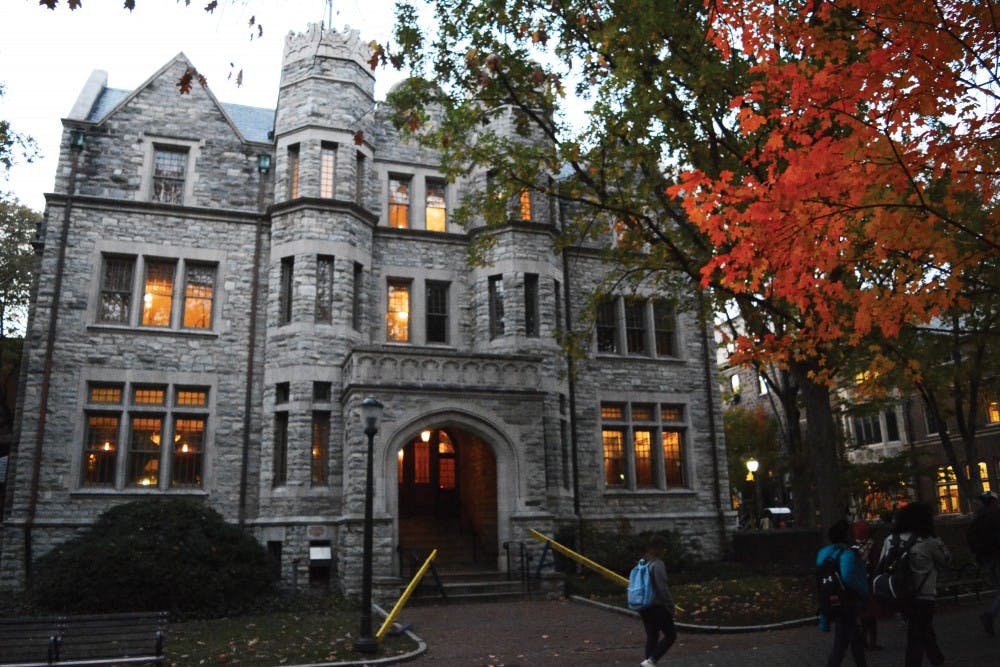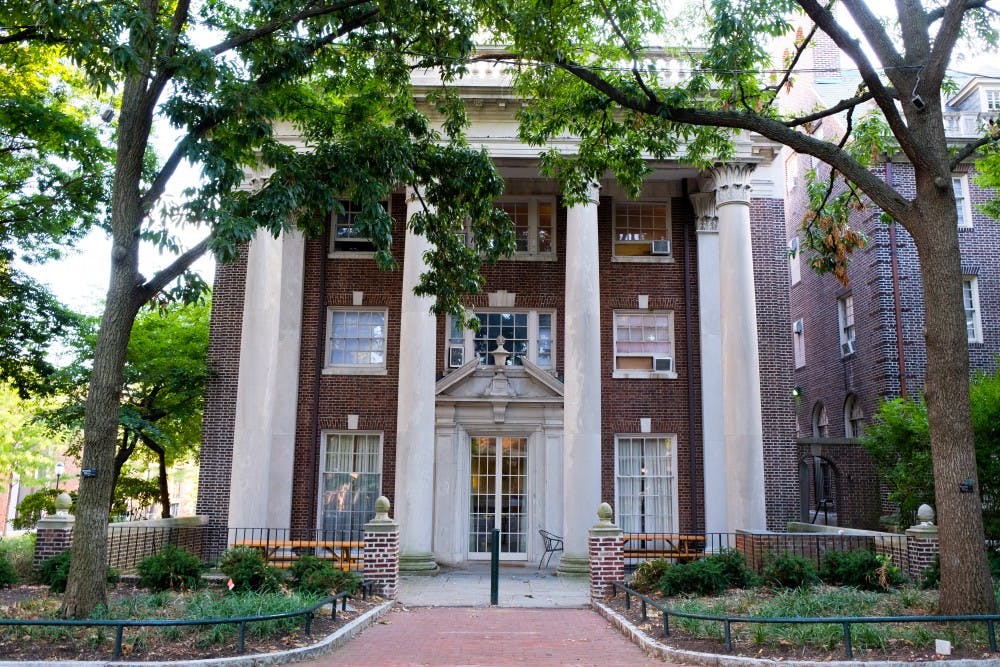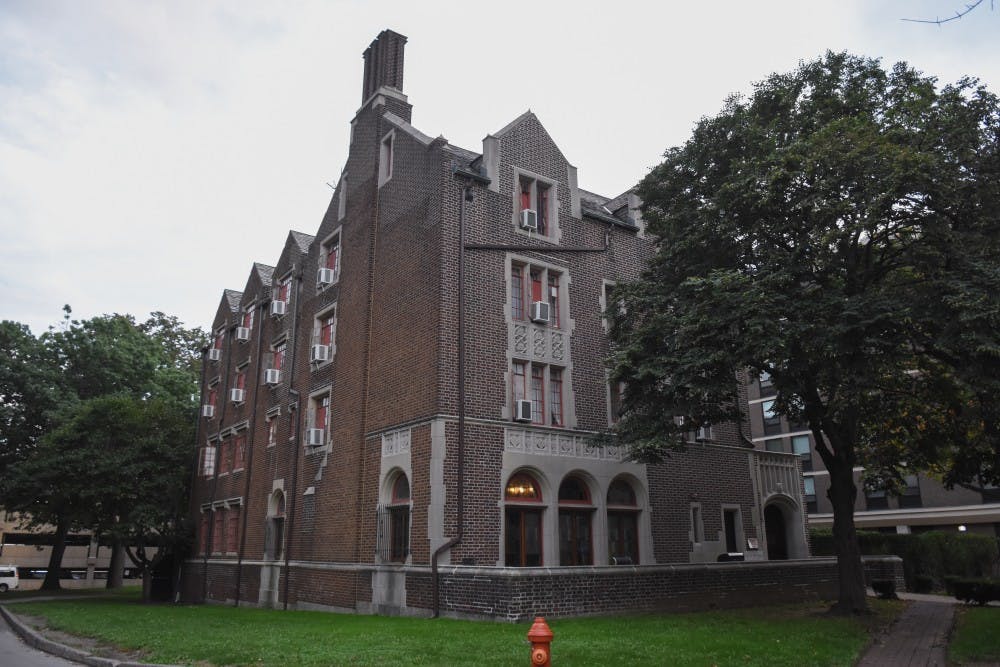Fallen leaves press themselves into exposed brick as students rush to class on Locust Walk. In Penn lore, Locust is shorthand for everything that’s idyllic and collegiate about campus—academic buildings, community, coming together. But look a little closer and you’ll notice something: the center of campus reads like a litany of Greek letters.
Phi Delta Theta, Phi Gamma Delta, Delta Phi. Passersby take photos bathed in the holiday lights outside of Kappa Sigma. Psi Upsilon is the backdrop of every photo taken in front of the LOVE statue.
Since Penn transitioned from being mostly a commuter school in the late 1800s, fraternities—and their houses—have become a central part of the physical and cultural landscape of the university.
In 2017, Emily Hoeven (C ‘17) published an opinion column saying, “to occupy the center of campus, you better pay up.” Since then, the debate around whether Penn fraternities benefit from financial protections and systems instituted or permitted by the school—has been at the forefront of the conversation around fraternities on campus. But that doesn’t mean Penn administrators, or many students, are willing to talk about why or how the system works.
The systems in place to protect fraternities are deeply entrenched in bureaucracy and are often difficult to navigate, from the politics surrounding fraternity real estate in the center of campus to the circuitous insurance policies that keep liability from falling on national chapters.
This October, there’s been mostly silence or obfuscation around the issue, from the Vice Provost for University Life (VPUL) the Office of Fraternity and Sorority Life (OFSL), and Facilities and Real Estate Services (FRES). And individual fraternity members have split loyalties: to their friends in their organizations, to the school, to the national chapter. Many of them don’t particularly want to talk. An email to the Interfraternity Council (IFC) came back with a referral to speak to individual members, and Reginal Murphy (C ’19), the IFC president, did not respond to multiple requests for an interview.

Reporting this story spanned March to October of 2018. It required parsing Daily Pennsylvanian archives from before World War II to find around 100 total words, poring over land deeds to find purchase dates and prices, and digging into city property tax records. More labor–intensive still was talking to Penn administrators, who provided referrals to each other in a loop that at times seemed infinite and defeating. And even pieced together, all of the available information hardly answers any questions.
Politics of Space
The fact that Locust Walk, Penn's most storied and traversed thoroughfare, is boxed in by fraternity houses, is more than indicative of Penn’s values and history. It’s also an issue of privilege—who is worthy of space, and who controls it.
From a common–sense perspective, the idea that fraternities have physical preference over campus’s most heavily trafficked walkway, that they can throw parties in their yards by the Compass, that their proximity to the center of campus is much closer than many cultural centers, has an indelible effect on the social and cultural climate of campus.
The Greenfield Intercultural Center—catering to first–generation, low–income students, Native students, and many other communities—is relegated blocks off–campus at 37th and Chestnut Streets. As Hoeven observed, Makuu, La Casa Latina, and Pan Asian American Community House (PAACH) share the bottom floor of the Arch Building. The LGBT center sits far on the west corner of campus.
In 1990, members of Psi Upsilon (Castle) reportedly kidnapped a brother of Delta Psi (St. A’s). Penn subsequently banned Castle from campus. Their house, in a prime location near College Hall, was unused. In the years following, the space housed a Penn residential program focused on community service.

Psi Upsilon (Castle) house on Locust Walk
Then–president of Penn Sheldon Hackney said that the choice to house a non–fraternity in "The Castle" was a move towards "diversifying the Walk…saying the center of campus is dominated by white, male fraternities."
Castle returned to its on–campus house in 1998. The program was moved to the 12th floor of a high rise. Penn's OFSL director at the time said “I’m very supportive of the Community Living and Learning Service Program… but the house was built by Psi U and they've been an institution at Penn for a long time.”
Fraternities get prime real estate, often at the expense of groups that cater to the student body writ large. Curie Shim (E ’20), the Chair of Penn Association for Gender Equity (PAGE), sees fraternity housing as an indicator of the University’s priorities, particularly in comparison to the space allocated to cultural centers: “When PAACH and La Casa [Latina] and Makuu each have one room and each fraternity has a whole building on campus, what does that say about how the university views these groups?”
She adds, “I can’t think of any other group that has that kind of priority on campus.”
The Subsidization Question
Data from the OFSL website says that “there are 32 official fraternity and sorority chapter houses on the University of Pennsylvania's campus, 24 of which are owned and operated by the University in conjunction with Campus Apartments, and 8 of which are privately owned or leased by their respective organizations.” Ownership structures get messy for many different reasons, but one major issue is taxation.
As Hoeven touched on in her editorial, Penn couldn’t house enough students in campus dorms in 1926, and on–campus fraternity houses had room to spare. So the University struck up a deal with fraternities: they would allow non–affiliated students to live in their privately owned frat houses. In return, the University would buy the properties at less–than–market value and institute a buyback clause: should the fraternities not need to house non–affiliated students anymore, the organizations can buy back the property for $1.00.
VPUL says that they are “unaware of any instance where the reversionary right [buyback clause] was triggered or exercised.”
But regardless of whether the right was ever invoked, some public–use spaces on campus were once fraternity houses. The Penn Women’s Center is perhaps the best–known example, as is the Jaffe History of Art Building.

Phi Delt house on Locust Walk
Land deeds from Penn’s project Mapping Penn and the City of Philadelphia allude to parcels of land purchased under the the terms of what was called the “Fraternity Dormitory System,” as was evidenced by some of the research in Hoeven's piece. This system allowed non–affiliated students—up until the 1980s—to live in fraternity housing. Fraternities counted as dormitories to supplement a lack of residence halls in the middle of the 20th century. And in return, Penn bought land titles around the buildings and assumed financial and operational responsibility.
The tax exemption was—and still is—in effect because, as titles belonging to the University, the frat houses constitute “real estate used for educational purposes,” as Hoeven reported.
Though not explicitly stated in the deeds, the system also shunted property taxes for these prime locations onto the University’s balance sheet. To defray the property tax costs, the University lobbied local government to accept a tax exemption, which passed in 1938 after 12 years of debate. Penn–owned fraternities no longer incurred property taxes on their houses in the middle of Locust Walk.
VPUL confirms that, currently, “University–owned fraternity houses are not subject to real estate tax.”
Follow the Money
VPUL, in April, did not grant an interview. They instead provided an information document created last semester for another writer and referrals to other Penn departments.
In these written answers from April 2018, Penn gave an unequivocal “no” to that writer’s questions about subsidies, repeating that “Penn does not subsidize fraternity houses” three times in a three–page document.
To look at what constitutes subsidizing—and how a school can support Greek houses without direct subsidies—it helps to follow the money.
Penn doesn’t pay rent for fraternity brothers, nor do they get a kickback every semester from the University. The real relationship is more subtle and comes down to institutional support and grandfathered–in clauses that give fraternities, and their houses, priority on campus.
The Executive Vice President’s office explained that “revenue generated by each Greek chapter house are pooled and stays within the collective Greek housing portfolio. This pool includes rent and out–of–house fees.”
But what is the portfolio? Who has access to the money, and is it at all augmented by University funds?

Executive Director of FRES Ed Datz responded to a question about the pooled portfolio by saying that “The 22 [fraternity] houses function as a unit,” and that different departments interact with the fund in different ways. FRES deals with operations and capital improvements, and VPUL/OFSL with programming, “in conjunction with the alumni groups.”
The money comes from dues and rent from individual Greek organization members but is pooled together—if something needs fixing at one Greek house, money from the collective fund can be used to those improvements. As for insurance, Ed says, “that’s more complicated.”
Some fraternities (eight Greek houses in total) have houses that are owned and operated by alumni or independent foundations. This introduces another stakeholder: the alumni foundations that own these houses and fund their operating budgets. One such house is Delta Psi, more commonly known as St. Anthony Hall, which draws funding from an organization incorporated as a charity. In other words, they're tax–exempt.
The St. Anthony 1907 Foundation has been tax–deductible since 2003 and is solely dedicated to “to restore and preserve of the historically and architecturally significant structure located at 3637 Locust Walk.”
Their most recent Securities and Exchange commission filing shows contributions of $463,024. Because it’s not owned by the school, Philadelphia property taxes still apply, and the funding comes from charitable donations.
Penn doesn’t own the space, and with that lack of ownership comes a lack of control over a building central to campus.
Fraternity Insurance
Another system surrounding fraternity life that's difficult to access information on is insurance.
The former national director of Delta Kappa Epsilon, David K. Easlick, is now an expert witness and lawyer in fraternity hazing and risk management. He’s also one of the few people who knows fraternity insurance clauses inside and out. And much like taxes and real estate, the system is confusing and purposefully opaque.

Zeta Beta Tau on–campus house
In a conversation this spring, he explained that fraternities operate much like big businesses at the national level—many of them are actually incorporated under 501(c)(3) designations. But fraternities only began to comport themselves like businesses after a huge restructuring in the 1980s.
Enter the Fraternity Insurance Purchasing Group. Boring name, but if there’s an inflection point that defined the modern fraternity system, this is likely it. Though the group never purchased any insurance, it did set up a 50–page risk management code that persists to this day. It is “ten basic standards that are,” to David, “utterly unenforceable and totally ridiculous.”
It was after the adoption of this code that one of the biggest technicalities in fraternity history came into play. “The insurance company takes the position that it won’t insure an illegality […] and there is nobody in these fraternities actually performing an act that is going to cause problems that is obeying the law. So, they are uninsured. The only entity that is insured […] is the national.”
In this system, individual undergraduates don’t benefit from the protections of the insurance they purchase—instead, it benefits the national level, the system at large.
It’s emblematic of how fraternities function: codified, constructed for the benefit of the organization at the expense of the individual, and extremely hard for the average observer to understand.
So, what now?
Reporting on fraternities and the many bureaucracies that entrench them in campus life is hard, often defeating work. But it needs to continue as long as these buildings occupy the physical and cultural center of campus. And even after frats leave campus, their influence often remains.
Penn’s chapter of Skulls still owns the building where, in 2011, a young man fell at a party and later died. They were sued by his family for negligence and wrongful death. The chapter was forced off–campus and went underground, leaving an open building at 3539 Locust Walk.
Now, Penn Violence Prevention is headquartered there. To use the space, the director of PVP says that they still pay rent to Skulls. FRES didn’t reply to an email inquiry.
This article was updated on October, 18th, 2018.
